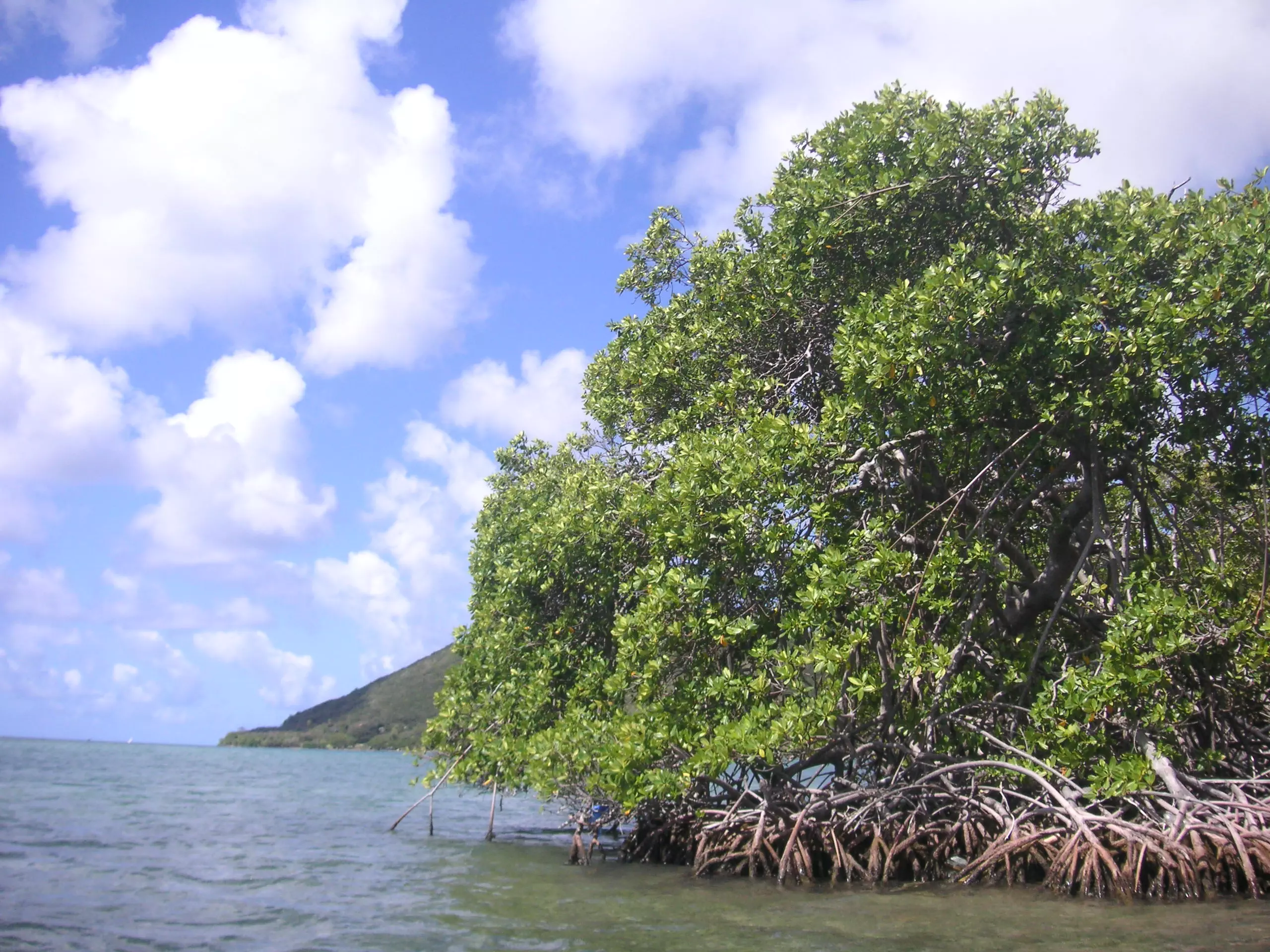
Mangroves are marine ecosystems of intertropical coastal regions, located at the bottom of sheltered bays. They are made up of trees that are highly adapted to this brackish environment, known as “mangroves”.
There are 4 species of mangrove in the West Indies:
– Red mangrove: seaside mangroves (deep water)
– Black mangrove: shrub mangrove (shallow water)
– White mangrove: in the dry zone
– Grey mangrove: in sandy soil that floods to a greater or lesser extent.
Martinique’s mangroves cover an area of some 1,800 hectares, representing around 4% of the island’s forest area.
Red and black mangroves are able to live in salt water thanks to an ingenious system for extracting salt. They filter the salt through their roots and the surplus is stored in the yellowing leaves, which are then condemned.
Thanks to its stilt roots, the red mangrove is able to stabilize itself in muddy soil.
These are examples of adaptation, and not all mangrove species function in the same way.
These plants have an exceptional ability to live in oxygen-poor soil, thanks to the lenticels (small pores) on their aerial roots (stilt roots, pneumatophores).
Protection against erosion : protects the coastline from the aggression of waves, storms and tsunamis.
Filtration of sediments and pollutants, preserving clear water for the development of coral reefs.
Refuge for the growth and feeding of fish (mullet, pisquette, tarpon, etc.), shrimps and lobsters.
Birds also need mangroves, as they are ideal for nesting. Without mangroves, birds would be deprived of a precious refuge.
We need to protect mangroves for the balance of marine ecosystems.
It represents the boundary between land and sea. Its leaves are thick and resistant to sea spray.
They grow in the sea and are held in place by their “stilt” roots. Its roots are aerial: they grow directly from the branches towards the ground.
A rich aquatic life develops on the roots, including sea oysters, sponges and sabellids (tubicolous worms).
It owes its name to the tannins that used to be extracted from its bark for dyeing.
It has medicinal properties against bites and stings.
They reproduce viviparously: the seed germinates directly in the fruit and grows into a seedling while still attached to the tree. When this seedling falls into the water, it settles in the mud.
Often, these seedlings are carried along by the water, where they can remain for several weeks and travel great distances while retaining their viability, hence the significant extension of mangroves along tropical coasts.
Black and white mangroves have aerial roots called “pneumatophores”. They rise to the surface around the trunk to supply the roots with oxygen.
The pneumatophores are protected by cork and pierced by small pores called “lenticels”, which allow gas exchange between the atmosphere and the tree.
The fiddler crab owes its name to the hypertrophy of one of its claws, which is much larger than the other in the male.
At low tide, it emerges to feed on decomposing animals and plants.
It digs its burrow in the mangrove mud, aerating the soil. In this way, it becomes an essential player in the survival of the mangroves.
It hides immediately in the mud if you come within 5 m of it.
If you stay at a safe distance, it will happily display its large claw in a surprising choreographic ballet.
In Martinique, it’s also known as the “C’est ma faute” or “Sé ma fòt” crab, due to the movement of its claw, which regularly folds over the front of its shell.
Mangroves are threatened by natural causes: tropical storms.
In Martinique, mangroves have long been considered dirty and unhealthy places. An ideal pretext for the construction of harbors (Fort-de-France), industrial zones, airports (Lamentin), houses, tourist resorts and so on.
Wild” pontoons are also built by cutting mangroves to moor boats.
The mangrove suffers from urban pollution (landfills, sewage, etc.), industrial pollution (hydrocarbons, metals, etc.) and agricultural pollution (pesticides, etc.).
Over the last 50 years, more than half the world’s mangroves have been destroyed by man.
3,000 years ago, Amerindians harvested oysters and hunted animals for food. Some species, such as the manatee and pink flamingo have already disappeared from West Indian mangroves due to over-hunting.
Mangroves were exploited for their resources: charcoal, timber (scaffolding) and tannin, made from mangrove bark.
In Martinique, the ONF and PRNM have set up various sites (the Etang des Salines, the Caravelle and the Baie des Anglais, for example) to observe the flora and fauna of the mangrove.
The mangrove swamps of Martinique are home to many magical places. Unhealthy manipulations and evil spells are performed in these quiet, isolated places. Popular belief has it that when a new day dawns in the morning, all such mischief disappears.
Chat with us directly from WhatsApp